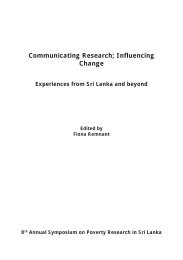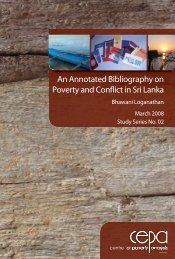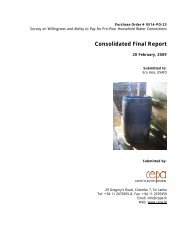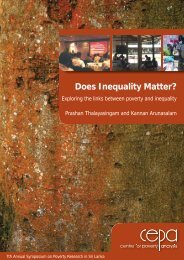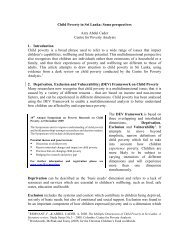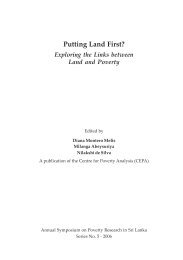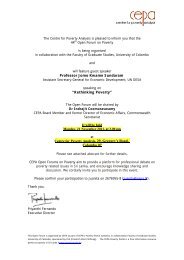Involuntary Displacement and Resettlement â Policy and ... - CEPA
Involuntary Displacement and Resettlement â Policy and ... - CEPA
Involuntary Displacement and Resettlement â Policy and ... - CEPA
- No tags were found...
You also want an ePaper? Increase the reach of your titles
YUMPU automatically turns print PDFs into web optimized ePapers that Google loves.
Gunewardene <strong>and</strong> Wickremasingha’s study (Chapter 1) of the social <strong>and</strong>economic impacts of resettlement on tsunami affected coastal fishersindicates the importance of livelihoods being restored in a manner that takesinto account long term sustainability. The widespread provision of boats, nets<strong>and</strong> other fishing equipment has alerted the fishing industry to the potentialdestruction of fishing stocks from over fishing, while the types of boats <strong>and</strong>nets provided has led to a reduction in Beach Seine Fishing (maa del), atraditional artisanal community based fishing method which needs aspecialised locally made net. This has had considerable impact on thelivelihoods of the fisher community in terms of loss of labour work.The following issues are thus critical to the restoration of livelihoods:The existence of early warning <strong>and</strong> preparedness for displacement(possible in cases of development induced dislocation, <strong>and</strong> to someextent through recognition of the vulnerability to disasters).The underst<strong>and</strong>ing of the differential impact of displacement <strong>and</strong>resettlement on different livelihood groups <strong>and</strong> the ability to addressthese different impacts with a varied portfolio of compensation thatcan also adequately compensate for the loss of livelihood assets.The time taken to address livelihood needs in the face of otherpriorities (e.g. restoring the home).The possibility of relocation in close proximity to the place ofdisplacement, to minimise disruption to social <strong>and</strong> economic networks<strong>and</strong> markets.The need to assess the long term sustainability of restored livelihoods,<strong>and</strong> to recognise how interventions can influence the differentfactors that affect a household’s livelihood portfolio.4 VulnerabilityThe process of displacement can be particularly difficult for those who arealready vulnerable (the poor, the elderly, people with disabilities) <strong>and</strong> it canalso create new vulnerabilities because of loss of livelihoods, adverseimpacts of displacement on mental <strong>and</strong> physical health, friction with hostcommunities, as well as other factors.6



